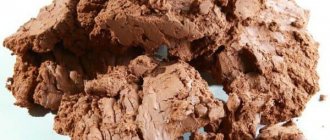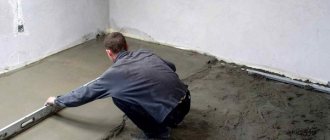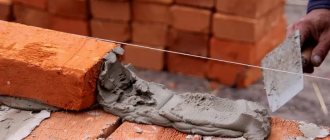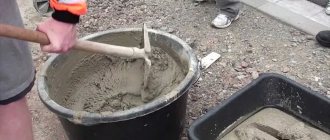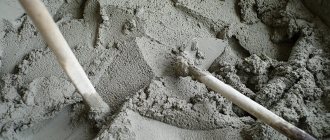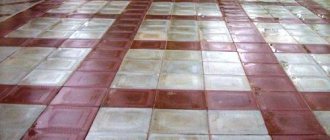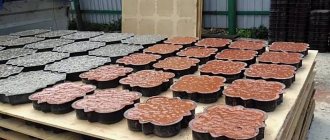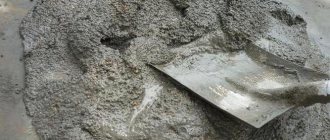In the construction market, gypsum and mixtures based on it are presented in a wide range. The materials are especially distinguished by the short period of use of the solution. Let's consider the technical characteristics, methods of using the finished mass and how to dilute alabaster and with what to carry out certain repair work. After reading the article, there will be practically no questions left for the specialists, and the consultants will select the correct type of composition.
Ready solution Source klinkerzakazat.ru
All about asbestos-cement mixture
The modern market offers a large selection of various ready-made finishing mixtures.
Professional builders prefer to prepare such solutions themselves. When finishing internal and external walls, an asbestos-cement mixture is used. You can prepare it not only on the basis of cement, but also sand, and even clay, the main thing is to know the proportions. Depending on the composition, it may set faster or slower. Sometimes asbestos cement mortar is used to finish stoves because it retains heat well.
Is asbestos in demand on the market?
Asbestos began to be widely used in industry in the 30s. The first study on the dangers of asbestos dust was conducted in 1910. But the press began to talk about the dangers of asbestos only in the 80s. Gradually, mineral production volumes began to decline. In 1980, global production was 4.7 million tons, and in 2000 it was only 2 million tons.
How the asbestos market has changed over 40 years is clearly shown in the diagrams:
Nowadays, asbestos is a popular material in the CIS countries, the Middle East and the countries of Southeast Asia. At least 1 million tons of asbestos are mined in Russia every year. About 75% of the extracted raw materials are exported. Asbestos prices have increased in 2022 and 2022 due to increased demand for building materials. The revenue of Russian companies from trading on the domestic and foreign markets in 2022 amounted to $400-600 million (according to estimates from various agencies).
Properties
Asbestos-cement mixture has a number of positive characteristics, which is why it is so often used in construction. The solution is plastic and has good tensile strength.
Asbestos paste is durable and versatile. Supplied in bags, dry. To create a solution you need to use water.
This cement coating is durable, resistant to sub-zero temperatures, waterproof and does not support combustion.
Types of asbestos
✍ Chrysotile asbestos
Chrysotile asbestos is white in color. The mineral consists of thin tubes with a diameter of hundredths of a micron. The tubules connect and form bundles with a diameter of up to 100 microns. Tensile strength is 600-800 MPa, like the best steel grades.
This mineral is resistant to alkalis, but in acids it breaks down to silica. Chrysotile fiber fluffs easily. The fluffy mineral has high adhesion. Other substances easily penetrate into the pores formed between the fibers.
✍ Amphibole asbestos
Amphibole asbestos can be green, green-yellow, golden or blue. The color of the threads depends on the deposit. The mineral has a crystalline structure consisting of needle-shaped fibers. It is more resistant to acids compared to chrysotile, but is inferior in strength. Amphibole was banned in many countries due to its carcinogenic effect.
Compound
The asbestos-cement mixture contains 70% cement, and you should choose a material of grade no lower than 400. The fiber itself is only 30%. Water is added in an amount of 10% by weight of the mixture. This is regulated by GOST.
The composition may contain gypsum, lime, clay.
The composition varies depending on which walls (internal or external) are finished.
Internal walls
Lime
For this mixture, take lime dough and sand, which can be from 1 to 5 parts. When adding water, everything is thoroughly mixed. To avoid lumps, sand is added gradually. The overall consistency should be close to that of the dough.
The mixture is prepared exclusively for the day.
Lime-gypsum
In addition to the previously listed components, gypsum is used. First, prepare gypsum dough. It’s not difficult to make, just pour the dry mixture into the water, stirring. Then the resulting product is mixed with lime dough until a homogeneous mass is obtained.
Portions should be small, since the composition sets quickly.
If you overdo it with water, then the solution will take longer to dry, and the coating itself will end up loose.
Cement-lime
Take for cooking:
At the first stage, sand and cement are combined, only after that lime paste is poured in. The proportions are 1: 1: 10, where cement, lime and sand come in order.
Facade
The sand is pre-sifted. The cleaner it is, the better the finish. Cement is taken grade 400, added in a ratio of 1: 4, where 4 parts are sand. If M500 is used, then the proportion changes - 1: 5. If the requirement is not met, the result will be a weak solution.
During production, dry ingredients are mixed and only then water is added.
The ideal result is the consistency of thick sour cream.
Lime
In some cases, lime is used to replace cement. This does not affect the quality of the finished product in any way. Only slaked lime without lumps is used. First, sand is placed on the bottom, then water is added, and only after that lime is added.
Clay
This mixture is made using cement, sand and lime. Only with them does the material become suitable for façade finishing. Some people add gypsum.
The clay is pre-soaked in water. On average, this process takes up to 3 hours. To prevent the clay from drying out, you need to add water. When it acquires the thickness of sour cream, you can use it.
Now it's time to add 0.2 parts of cement. Mix everything and add sand little by little. For 1 portion of clay it is necessary to add 0.3 parts of lime, which is used instead of sand.
Practical use of the material and reasons for its demand
The combination of the positive performance characteristics of sheet asbestos cement and their predominance over the disadvantages of the material allows its widespread use in the domestic construction industry, including for:
- external cladding of walls of industrial, residential, warehouse and agricultural buildings;
- arrangement of ventilated facades as facade slabs;
- formation of light fences, other enclosing structures, lining of balconies and loggias;
- assembling composite screeds when installing flat roofs from rolled materials;
- installation of wall sandwich panels during the construction of low-rise construction projects;
- creating permanent formwork when pouring foundations and walls;
- arrangement of pitched roofs.
It is convenient to use cuttings of asbestos-cement slabs to create flower beds, limit high beds and other economic purposes.
When installing roofs made of asbestos cement sheets, it should be taken into account that if the roof slope is less than 12 degrees. It is possible for water to stagnate on the roof and flow into the premises through the joints of the panels. To cover temporary or light buildings, it is advisable to use inexpensive flat sheets with a thickness of 6-8 mm. Complex roofs of permanent buildings often require corrugated slate. This requires the creation of an adequate rafter system from boards with a section of 100-150 mm with a distance between them of about 1 m. Before laying the asbestos cement itself, it is necessary to take care of reliable vapor barrier of the roof and create a reliable sheathing from 5x5 cm timber. Before starting installation operations, all wooden structural elements are useful treat with fire-fighting compounds and antiseptic.
Large reserves of asbestos raw materials in the domestic subsoil, along with improving the technology for the production of environmentally friendly asbestos-cement sheets, are significant prerequisites for maintaining the production volumes of this building material and expanding the scope of its application. And taking into account the low price of asbestos cement relative to popular modern analogues, its demand for construction purposes remains stable for the foreseeable future.
Application
Asbestos cement mortar is used as insulation on walls and more. Thanks to such a crust, it is possible to retain heat. It is not susceptible to moisture. Asbestos fibers make the surface smooth, and if you plaster the wall afterwards, cracks will not appear.
It is rare, but it happens that asbestos solution is used for thermal insulation of a pipeline or ventilation duct. This mixture has a high asbestos content. The composition is used when necessary to strengthen joints between pipes made from the same asbestos.
Among other things, the solution can be used as a filler when laying socket pipes. Thanks to it, the joints have greater elasticity.
Internal and external walls can also be covered with asbestos cement mortar. It is also used for stoves.
Preparation
You can make asbestos cement with your own hands if you know the proportions. For the oven are used:
- chalk powder;
- clay;
- asbestos.
Sometimes sand or fiberglass is used as a filler.
If gypsum is used as the main raw material, then in combination with fiberglass, lime and sand, the ratio should be 1: 0.2: 2: 1.
Clay can also be the main filler, so it is applied half and half with sand. The fat content of clay plays an important role. The resulting mixture must be viscous, otherwise plastering the walls will be inconvenient.
Clay mortar comes in the following types:
- asbestos, sand, clay – 0.1: 2: 1;
- cement, clay, asbestos, sand – 1: 1: 0.1: 2;
- lime, asbestos, clay, sand – 1: 0.1: 1: 2.
Any mixture of asbestos and cement is a durable and unique finishing material. 20 years ago it was used to make products such as pipes and slate.
Strength and reliability are what primarily distinguishes a solution with asbestos.
You can learn how to properly mix concrete mixtures from the video below.
Source – https://stroy-podskazka.ru/cement/asbestocementnaja-smes
Slate roofing: what materials should be used to repair?
Asbestos-cement wave slate is widely used in roofing of private houses, garages and country houses. This material has good wear resistance, but it cannot last forever. 10-12 years pass after laying the slate sheets, and chips and cracks begin to appear on their surface. The roof, becoming fragile, allows water, dust, cold into the room and ceases to be a reliable protection for housing. However, do not despair, as you can repair the roof yourself and extend its service life for another 6-10 years. To make a quality slate roof repair, you need to use several simple methods.
You can do the slate roof repair yourself without requiring expensive materials.
How to properly dispose of asbestos
The best solution is to take the asbestos to a hazardous waste collection point. But such points are not available to all residents of Russia. Some waste collection points may not accept asbestos products. This is due to the fact that in Russia there are few factories that can process asbestos. Most of the waste is subject to disposal at landfills.
Active processing of asbestos is carried out in the European Union. Asbestos disposal is carried out by heating to 1500-1700°C. After melting, a vitrified substance is obtained that does not release carcinogens. The product remains fire resistant and can be used as a fire retardant material.
In 2022, Thermal Recycling patented a new method for neutralizing asbestos. Denaturation at high temperatures is used to utilize the mineral. The first furnace using the new technology was launched in 2022. After launch, 200 tests were carried out and no asbestos fibers were found in any of the processed products.
What does an asbestos denaturing oven look like?
Although the material deactivates at high temperatures, it is not recommended to burn slate and other asbestos products at home. The material often explodes after heating. Slate has a heterogeneous structure; when heated, internal tension is formed. The sheets explode and break into fragments with sharp edges. During an explosion, a lot of kinetic energy is released, so the fragments fly over a long distance.
Roof repair using cement-asbestos mortar
Today, the technology of restoring roofs made from slate sheets is popular among owners of houses and cottages, allowing to extend the life of the roof to 10 years or more.
The method is very simple, and to use it, you do not need to purchase expensive building materials. For repairs you will need PVA glue, asbestos, grade 300 cement and water. Asbestos should be purchased fluffed; if this is not available for sale, you can take asbestos chips and grind them in a mortar to a powdery state. Block asbestos is also suitable, but it must first be grated. If PVA glue is not at hand, it can be replaced with any water-based frost-resistant paint.
Before starting slate repairs, it is necessary to clean, rinse and dry all damaged areas, and then prime and cover with cement-asbestos mortar.
Before you begin the roof repair itself, you should carry out preparatory work. It is necessary to sweep away all debris from the roof with a broom, and thoroughly clean damaged areas with a stiff brush. After sweeping, the roofing covering is washed under strong water pressure from a hose and allowed to dry completely. When the roof dries, it must be coated with a primer made from PVA glue and water in a ratio of 1:3, and left until completely dry, then primed again. After the roof has dried again, you can begin the main restoration work. Repairs should be carried out in warm but cloudy weather.
To prepare a mixture for slate restoration, you need to mix cement and asbestos in a ratio of 1:3 and dilute them with a primer of PVA glue and water, prepared according to the method described above. Water-based paint used instead of glue does not need to be diluted with water. A solution of cement with asbestos and a primer are taken in equal proportions. The finished mixture should have a consistency similar to medium thick sour cream. The solution must be prepared immediately before repair work, since its shelf life does not exceed 3 hours. If the roof is large and its restoration requires a lot of time, it is advisable to prepare the mixture in small portions.
The resulting solution is used to treat all slate damage. In order for the roof to last as long as possible, the mixture must be applied to the cracks with a wide paint brush in at least 2 stages. The thickness of the cement-asbestos mortar layer must be at least 2 mm. Do not forget that slate sheets are a rather fragile material, therefore, in order to prevent new damage from occurring during roof repairs, you should use a special stepladder equipped with transverse pads.
Is it true that asbestos is dangerous?
Asbestos is a category 1 carcinogen. Amphibole poses the greatest danger. Therefore, it has been banned for use in the European Union since 2005. Amphibole asbestos is easily destroyed during processing. It breaks down into straight, needle-shaped fibers. Inhalation of fine particles is a carcinogen.
Even relatively safe chrysotile cannot be worked without respiratory protection. But in our country this rule is often neglected.
The risk of inhaling carcinogenic dust arises during mineral mining and when crushing asbestos objects. While working, you should wear personal protective equipment: respirator, goggles, protective suit. You can work with asbestos outdoors or indoors with good ventilation. After work, wet cleaning and ventilation should be carried out.

